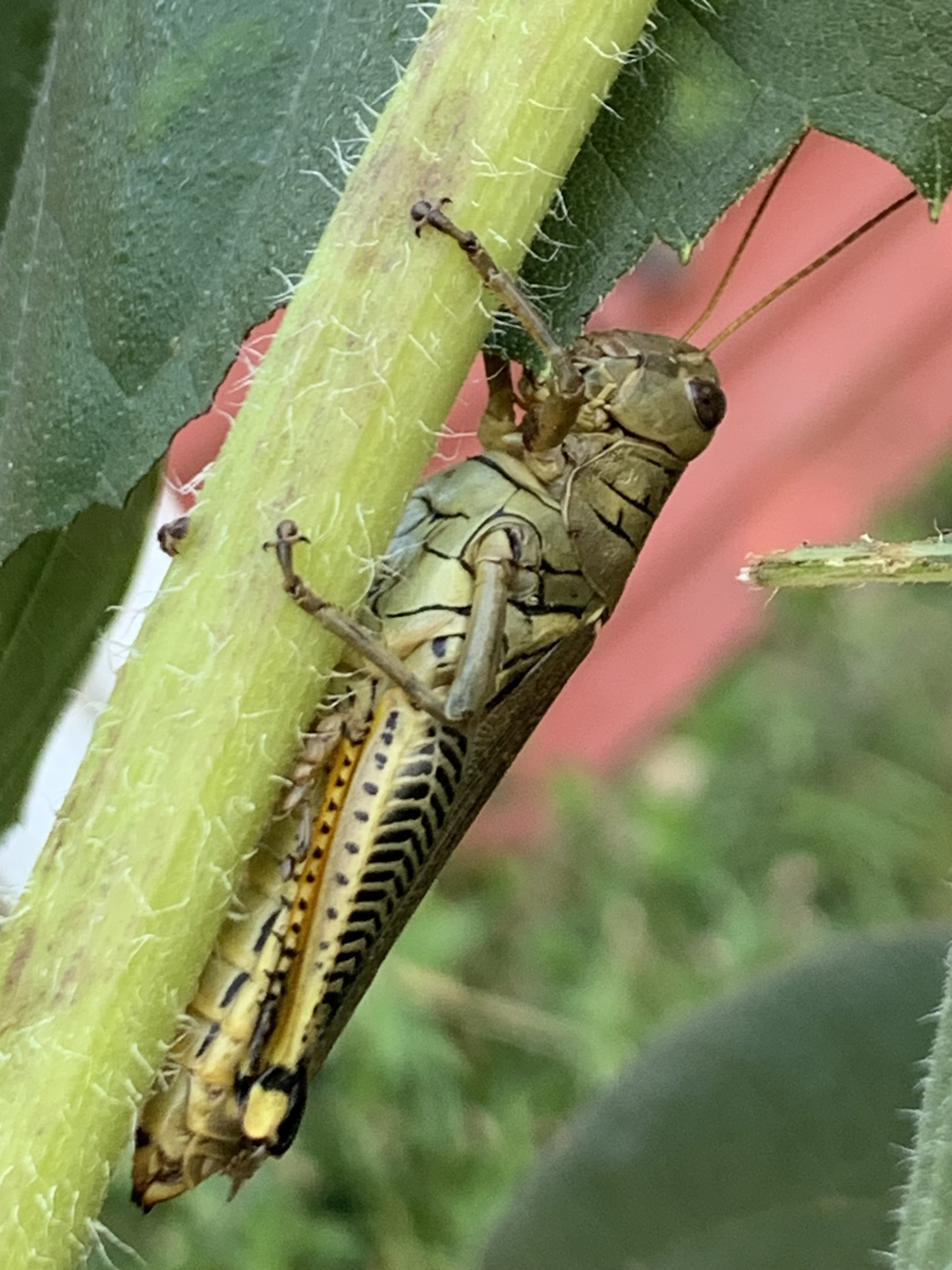We planted a couple of big sunflowers that a friend gave us, and they have thrived, producing huge flowers and then handfuls of sunflower seeds. On a cool autumn morning, the sunflowers are hosting grasshoppers. The grasshoppers are too cold to do much but sit there and look at the camera while Bryan takes their picture. Later in the day they’ll warm up and hop away. One of them has lost a leg. It may have disconnected the leg on purpose in order to escape a predator. It will still be able to hop away when it warms up.
About 650 different species of grasshoppers are native to North America. Five species that call Iowa home include the two-striped grasshopper, the bird grasshopper, the red-legged grasshopper, the spur-throated grasshopper, and the differential grasshopper. The grasshoppers sitting on our sunflower are most likely the common species (Melanoplus differentialis), or the differential grasshopper. They’re green and about two inches long. They have yellow legs with a herringbone pattern on the femur, the large, first segment of their back legs,) and black saw-toothed spikes on the tibia, the next segment.
Last fall, after they mated, female grasshoppers deposited egg pods containing up to 200 eggs in the soil. The embryos all developed to 54 percent of the way to hatching and then shut down for the rest of the winter. In the spring the embryos completed their maturing process so that they were all ready to hatch at about the same time regardless of when the eggs were laid. They hatch when the soil temperatures begin to rise. When grasshoppers hatch, they look more or less like miniature wingless versions of the adults. Over the next month, they shed their outer skeletons five or six times, growing bigger with each molt. At first they tend to stay close to their hatching site. Soon, though, they band together and go hopping and crawling in waves towards their next food source—a field or garden. At their fifth molt, they earn their wings and become strong fliers. Now they can fly off either in a group or solo to find food.
At night, the grasshoppers rest high in the foliage, such as on our sunflower. On a clear morning, when air temperatures rise to about 65 degrees, they start moving down the plants to bask in the sun. They’ll start eating when it reaches 68 degrees. They’ll spend the rest of the summer eating grasses and forbs, and they’re particularly fond of plants in the aster family, like sunflowers and ragweed. They’ll also eat some vegetables and fruits. They make a tasty meal for wasps, field crickets, beetles, flies, and birds, and some flies lay their eggs on them.
Some species of grasshoppers make a kind of clicking noise with their wings in late summer when they’re mating, and some species rub their legs on their wings to make sounds like a cricket does. But most, including our differential grasshoppers, don’t make much noise at all.
You find them in weedy places around fields and roadsides, pastures and other places where grasses and weeds have been left to grow. When they’re startled, the grasshoppers can jump up to 20 times their body length using those oversized hind legs of theirs. They’ll also spit a brown liquid (we call it tobacco juice) as a defensive move if they’re captured. They don’t restrict themselves to weeds, though. They can cause a lot of damage to crops. The nymphs like small grains and alfalfa, and they can strip a young corn field in a matter of days. The adults will move en masse into a cornfield and complete the job. They’ll also attack soybeans and cotton. But they’re not as devastating as the locusts that demolished pioneer crops in the 1870s and 1880s.
The locusts that covered the great plains from the Rockies to the Mississippi were called Rocky Mountain locusts. Locusts are related to grasshoppers, but they have the uncanny ability to either live as solitary leaf-eaters, or to change into those terrifying insects that destroyed crops in great hordes. We don’t see those hordes of horrors today because the Rocky Mountain locusts are extinct. The reason for their extinction is unclear, but habitat loss is thought to have played a major role as more and more land was developed into cropland.
Photo by Author. Alt text: Green insect with dark chevron markings on the long hind legs it uses for jumping. Differential grasshopper clings to a sunflower stem in the early morning light. Too cold to move now, it will warm and become active with the sun’s arrival.

1 comment
Fun! And Dave loves to play with them when they jump in the prairie!